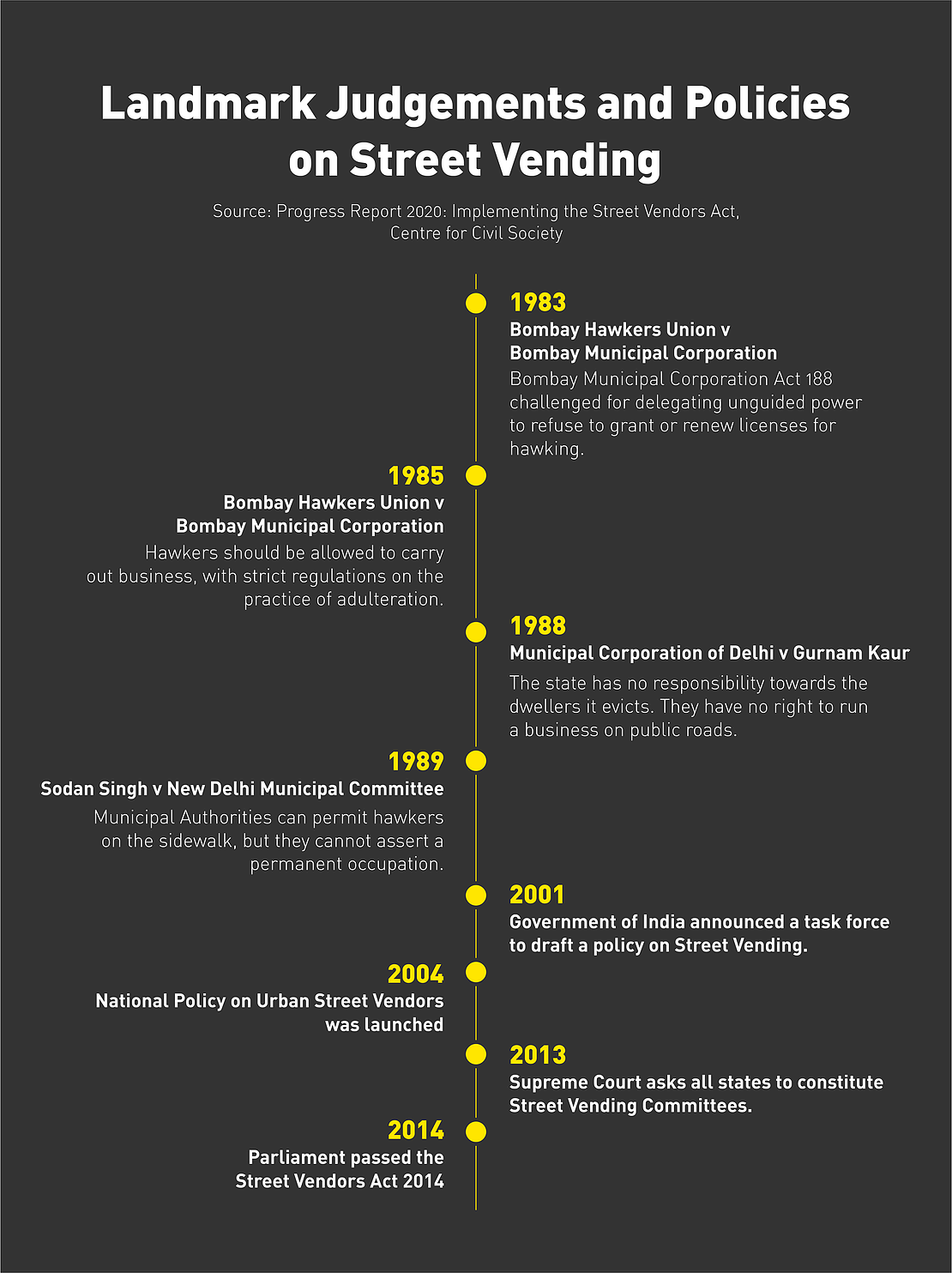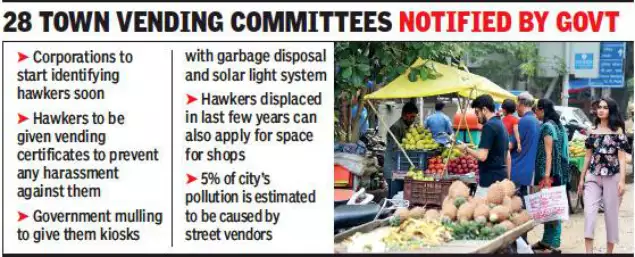Social Justice
Street Vendors: Assessing their Significance and Struggles
This editorial is based on “Implementing the Street Vendors Act” which was published in The Hindu newspaper on 1/05/2024. The article examines multidimensional aspects of the Street Vendors (Protection of Livelihood and Regulation of Street Vending) Act, 2014 and numerous challenges in its implementation.
For Prelims: Street Vendors (Protection of Livelihood and Regulation of Street Vending) Act, 2014, PM SVANidhi Scheme, Deendayal Antyodaya Yojana-National Urban Livelihoods Mission (DAY-NULM), Urban Local Bodies (ULBs) Vending Certificates (VCs), Grievance Redressal Committee, Fundamental Rights, DPSPs, Ministry of Housing and Urban Affairs, Self-Help Groups (SHGs), Town Vending Committees (TVCs), NULM
For Mains: The Street Vendors (Protection of Livelihood and Regulation of Street Vending) Act, 2014, the issues and challenges related to the Act.
It has been a decade since the enactment of the Street Vendors (Protection of Livelihood and Regulation of Street Vending) Act on 1st May, 2014. It was hailed as a forward-looking legislation that aimed to uplift street vendors by legalising their vending rights However, the legislation has been encountering significant hurdles in its practical execution.
Street vendors constitute a vital component of the urban economy due to their substantial presence in major cities, offering essential day-to-day utility items. they serve as indispensable nodes in the urban economic ecosystem, providing access to fundamental necessities for residents.
Who are Street Vendors and What are their Associated Rights?
- Definition:
- A street vendor is an individual who sells goods to the public without a permanent built-up structure for vending.
- They may operate from stationary positions on pavements or other public/private spaces, they may be mobile, carrying their merchandise on push carts or in baskets.
- Population:
- The number of street vendors has significantly increased in major cities worldwide, particularly in developing regions like Asia, Latin America, and Africa.
- In India, approximately 49.48 lakh street vendors have been identified, with Uttar Pradesh having the highest count at 8.49 lakh, followed by Madhya Pradesh at 7.04 lakh. Conversely, Delhi has about 72,457 identified street vendors, while none have been identified in Sikkim.
- Constitutional Provision - Right to Trade: Article 19(1)(g) of the Indian Constitution grants citizens the fundamental right to practise any profession, trade, or business.
What is the Street Vendors (Protection of Livelihood and Regulation of Street Vending) Act, 2014?
- Legalisation:
- It was implemented to legalise the vending rights of street vendors (SVs).
- Its objective was to safeguard and regulate street vending in urban areas, with State-level regulations and programs overseen by Urban Local Bodies (ULBs) through the formulation of by-laws, planning, and enforcement.
- Roles and Responsibilities:
- It outlines the roles and responsibilities of both vendors and various levels of government.
- It envisages to accommodate all 'existing' vendors in designated vending zones and issue Vending Certificates (VCs).
- It establishes a participatory governance framework through the creation of Town Vending Committees (TVCs), where street vendor representatives must constitute 40% of the members, with a sub-representation of 33% for women SVs.
- These committees are responsible for ensuring the inclusion of all existing vendors in vending zones and it includes mechanisms for addressing grievances and disputes, proposing the establishment of a Grievance Redressal Committee chaired by a civil judge or judicial magistrate.
- Conducting Survey:
- It mandates that States/ULBs conduct surveys to identify SVs at least once every five years.
What is the Significance of Street Vendors in India?
- Livelihood Generation:
- They serve as a vital source of income for millions of people, particularly migrants and the urban poor. It offers them opportunities for self-employment and sustenance amidst challenging economic conditions.
- Beyond the vendors themselves, street vending creates indirect employment opportunities in supply chains, logistics, and support services.
- Accessibility of Goods and Services:
- Street vendors play a crucial role in providing affordable and accessible goods and services to urban residents.
- From fresh produce to ready-to-eat snacks, their offerings fulfil daily needs and contribute to food security in cities.
- Cultural Heritage Preservation:
- Street vendors are often custodians of culinary traditions and cultural practices. Their offerings, such as Mumbai’s vada pav and Chennai’s roadside dosai embody their significance,
- Artisanal crafts reflect the diverse cultural heritage of India's regions and communities.
What are the Government Initiatives for Street Vendors?
- PM SVANidhi Scheme:
- PM SVANidhi Scheme launched by the Ministry of Housing and Urban Affairs, aims to provide affordable working capital loans to street vendors to restart their businesses or expand their existing ones. It also offers incentives for timely repayment.
- National Urban Livelihood Mission (NULM):
- NULM is a centrally sponsored scheme that aims to reduce poverty and vulnerability of urban poor households by enabling them to access gainful self-employment and skilled wage employment opportunities.
- It includes provisions for skill training, capacity building, and access to credit for street vendors.
- Urban Street Vendors (USV) Component under DAY-NULM:
- This component of the Deendayal Antyodaya Yojana-National Urban Livelihoods Mission (DAY-NULM) focuses on street vendors.
- It provides support for setting up and upgrading vending infrastructure, organising vendors into Self-Help Groups (SHGs), and facilitating access to credit and social security schemes.
- Skill Development Initiatives:
- Various skill development programs and vocational training initiatives are implemented to enhance the capabilities of street vendors, enabling them to diversify their livelihood options and improve their earning potential.
- Town Vending Committees (TVCs):
- Under the Street Vendors Act, Town Vending Committees are formed at the municipal level to facilitate the implementation of the Act's provisions.
- These committees are responsible for identifying vending zones, issuing vending certificates, and addressing grievances of street vendors.
- State Specific Provisions:
- Maharashtra, Rajasthan, Karnataka and West Bengal have framed state-specific provisions for street vendors under the Street Vendors Act 2014.
What are the Challenges Faced by Street Vendors in India?
- Administrative Challenges:
- Heightened Harassment and Evictions: Despite the Street Vendors Act which focuses on protection, street vendors endure increased harassment and eviction, often stemming from outdated bureaucratic attitudes to treat them as illegal migrants.
- Lack of Awareness and Sensitization: There is a dearth of understanding among state authorities, the public, and vendors regarding the Act's provisions, resulting in gaps in implementation.
- Limited Representation in TVCs: Street vendor representatives in Town Vending Committees (TVCs) often lack influence, and the inclusion of women vendors remains superficial.
- Governance Challenges:
- Inadequate Urban Governance Mechanisms: The Act's alignment with urban governance frameworks is deficient, and Urban Local Bodies (ULBs) lack the necessary authority and capacity.
- Neglect in Urban Development Initiatives: Programs like the Smart Cities Mission prioritise infrastructure development over the integration of street vendors, undermining the Act's objectives.
- Exclusionary Urban Development: Conventional perceptions of 'world-class cities' marginalise street vendors, impeding their acknowledgement as legitimate contributors to urban life.
- Societal Challenges:
- Impact of Climate Change and Tech Advancements: Street vendors confront new challenges from climate change, competition from e-commerce, and declining incomes, necessitating innovative responses.
- Stigma on Urban Image: The societal view of the high-tech urban sphere perpetuates the condition of street vendors, depicting them as hindrances to development instead of recognising their importance as integral members of urban communities.
- Extortion Racket:
- Cases of ‘rangdari tax’ and ‘hafta’ are common. In many cities, vendors have to part with substantial money in order to ply their trade.
What More can be done to Improve the Condition of Street Vendors?
- Strengthen Implementation:
- This includes identification processes, increasing awareness (through educational workshops, collaboration with NGOs, peer-to-peer community learning, collaboration with local authorities about available benefits), and ensuring accessibility of support programs.
- Expand Benefits:
- Street vendors should be provided with a broader range of benefits, including accident relief, compensation for natural death, educational support for children's higher studies, and pensions during times of crisis.
- Prevent Harassment:
- Ensuring that street vendors are not subjected to arbitrary evictions, confiscation of goods, or unfair fines is crucial to protecting their right to earn a livelihood.
- Enhance Representation:
- Street vendors should have meaningful representation in decision-making bodies such as Town Vending Committees (TVCs) to ensure their voices are heard in matters affecting their livelihoods.
- Increasing the representation of street vendors, particularly women vendors, can lead to more inclusive policies and better outcomes for this marginalised group.
- Promote Financial Inclusion:
- Facilitating access to formal financial services such as credit, savings, and insurance can help street vendors manage their finances more effectively and invest in their businesses.
- Microfinance institutions, self-help groups, and digital banking solutions can play a crucial role in promoting financial inclusion among street vendors.
|
Drishti Mains Question: Discuss the challenges faced by street vendors and suggest the policy measures that can be taken for their empowerment. |
UPSC Civil Services Examination, Previous Year Questions (PYQs)
Q. How has globalisation led to the reduction of employment in the formal sector of the Indian economy? Is increased informalisation detrimental to the development of the country? (2016)






